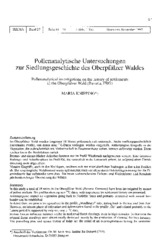Pollenanalytische Untersuchungen zur Siedlungsgeschichte des Oberpfälzer Waldes
Knipping, Maria
Knipping, Maria, 1997: Pollenanalytische Untersuchungen zur Siedlungsgeschichte des Oberpfälzer Waldes. In: TELMA - Berichte der Deutschen Gesellschaft für Moor- und Torfkunde, Band 27: 61 - 74, DOI: 10.23689/fidgeo-3377.
 |
Dokument öffnen: |
Im Oberpfalzer Wald wurden insgesamt 18 Moore pollenanalytisch untersucht. Sechs siedlungsgeschichtlich interessante Profile, von denen neue 14C-Daten vorliegen, werden vorgestellt. Anthropogene Eingriffe in die Vegetation, die wahrscheinlich mit Viehwirtschaft in Zusammenhang stehen, können aufgezeigt werden. Diese reichen bis in das Neolithikum zurück.
Bronze- und eisenzeitlicher Ackerbau konnten nur im Profil Windbruch nachgewiesen werden. Eine intensive Rodungs- und Ackerbauphase im Profil Öd, die vermutlich in die Latènezeit gehört, ist aufgrund einer Einzeldatierung nicht abgesichert.
Massive Eingriffe, auch in den Hochlagen, zeichnen sich mit mittelalterlichen Rodungen in fast allen Profilen ab. Der ursprüngliche Waldbestand wurde spätmittelalterlich vor allem durch Holzkohlegewinnung für die Eisenindustrie fast vollständig vernichtet. Die heute vorherrschenden Fichten- und Kiefernforste sind Resultate jahrhundertelanger Übernutzung der Wälder. In this study a total of 18 mires in the Oberpfalzer Wald (Bavaria, Germany) have been investigated by means of pollen analysis. Six profiles showing new 14C dates, with importance for settlement history are presented. Anthropogenic impact on vegetation going back to Neolithic times and probably connected with animal husbandry can be established.
In detail there are proofs for agriculture in the profile ,,Windbruch“ only, dating back to Bronze and Iron Age. However, an intense phase of cultivation and deforestation found in the profile „Öd“ and related probably to the Latène period is supported by only one single l4C date.
Serious human influence becomes visible in mediaeval forest clearings, even in high altitudes. In that time the original forest standings were almost totally destroyed, mostly by the production of charcoal for iron industry. The prevailing pine and spruce forests of today are the result of an over-exploitation lasting for centuries.

